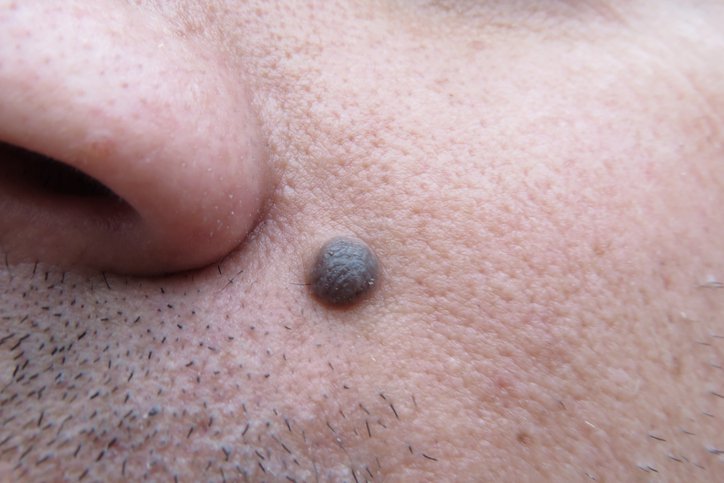Contents:
Medical Video: Freckle, Mole or More? Making Sense of Skin Cancer
Almost everyone has at least one mole on his body.
Moles often appear in childhood. If you are born with a mole, these spots are considered a birthmark. Birthmarks are the result of color pigmentation of melanocytes (skin pigment cells) that clump together for no apparent reason.
This skin condition is generally harmless, however, some moles can turn into cancer.
How to distinguish normal moles and symptoms of skin cancer
Unusual forms, wounds, bumps, suddenly appear unnoticed, or a change in appearance or sensation in the skin area may be a sign of melanoma or other types of skin cancer - or as an early warning.
Normal mole
Normal birth moles are usually evenly colored - brownish, blue-gray (Mongolian spot), reddish (salmon patches), purplish (hemangioma), jet black. People with skin or dark hair tend to have darker moles than those with white or blonde hair.
Moles can blend evenly with the skin or arise raised, even with hair growth. The shape can be perfectly round or oval. Normal birthmarks are generally less than 6 millimeters in diameter (as wide as an eraser on the tip of a pencil).
Some birthmarks can be present once you are born, but most appear during childhood or early adulthood. After the mole develops, they will usually still have the same size, shape, and color for years.
Some moles may darken (during pregnancy), increase (during adolescence), or fade (in old age: 40-50 years and above) in response to hormones. When you reach adulthood, you may have 10 or more birthmarks on your body.
Moles that just appear later must be examined by a doctor.
Moles are a sign of skin cancer
The most important warning sign of melanoma is a new mole that appears on the skin (early adolescence).
Melanoma, one of the most deadly forms of skin cancer, may begin as a flat mole and eventually expand. In rare cases, the skin condition may not be pigmented.
The "ABCDE" guideline is another way that can make it easier for you to distinguish anywhere that is a classic sign of melanoma. If you have one of the warning signs below, immediately notify your doctor to get the right diagnosis.
A for Asymmetry (Asymmetry)
Normal moles have a perfectly symmetrical shape, where one edge will match the other. Birthmarks suspected of being a symptom of skin cancer will have incompatibility in size and shape. This is because the cell on one side grows faster than the other. Cancer cells will tend to develop faster than normal cells, and in irregular patterns.
B for Border
The edges of a normal birthmark will have defined limits, apart from which your skin color ends and where the color pigmentation due to the mole begins.
If the periphery of the birthmark appears blurred - like someone who is coloring outside the line - this can be a sign of cancer. Ragged or opaque edges are also caused by uncontrolled cancer cell growth.
C for Color (Color)
As long as the color remains solid, equally flat on all sides, your mole is normal and nothing to worry about. However, if you see a variety of shades in one area of the mole, your birthmark can be cancerous.
Melanoma will be shaped like a blotch that has different shades from one color family. For example, in the middle of a pink that gradually darkens reddish on the edges, or vice versa (only red or pink moles are normal). Or, a cancer mole can show completely different color spots in one place, such as red, white, gray in a mole.
D for Diameter
Normal birthmarks will remain the same size all the time. A mole that grows suddenly, larger than 6 mm, can indicate a problem. However, melanomas are also sometimes found in smaller sizes than they should.
E for Evolving
Change is a bad sign when talking about birthmarks. Moles change color, size, shape so that they look very different than all the other moles on your skin indicating that this is your time to see a doctor.
It is also important to carry out regular self-skin checks to monitor birthmarks that experience growth or changes in color or suspicious shape.
Beyond the ABCDE guidelines, also pay attention to any other differences that may appear on your birthmark - such as redness, scaling, bleeding, pus, swelling outside the edges of moles, itching, pain, or pain when touched.
In addition, note the three characteristics below:
- There are more than 100 moles in your body
- Most are more than 8 mm in size
- Most are atypical
If you have three characteristics of this mole, called "classic atypical mole syndrome", you are at high risk for developing melanoma. Your chances will increase dramatically if you not only have this syndrome, but also have close family members (level one or two) who have melanoma. While atypical birthmarks often occur in childhood, they can appear at any time in life in people with this condition.
READ ALSO:
- What are the Effects of Tanning on Skin Health?
- Is it true that Asian people are more youthful than "bule"?
- Tips for Recognizing Harmful Skin Whitening Creams












